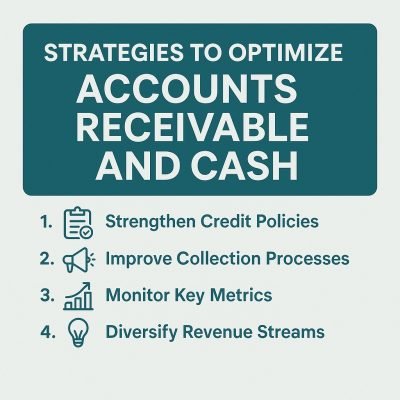Strategies to Optimize Accounts Receivable and Cash

Efficiently managing your accounts receivable and cash flow is essential for maintaining financial health and ensuring operational success. By implementing targeted strategies, businesses can improve liquidity, streamline operations, and reduce the risks associated with delayed payments.
In many cases, service-oriented and wholesale businesses rely on accounts receivable, while retailers, restaurants, and similar establishments often receive immediate payments through cash, credit, debit cards, or checks. Additionally, accounts receivable businesses usually interact with other business owners, whereas cash-based businesses primarily serve customers from the general public. Despite these trends, modifications can be made to promote increased cash flow into a business.
Below are four actionable approaches to optimize Accounts Receivable and Cash:
Strategies to Optimize Accounts Receivable and Cash
- Strengthen Credit Policies
- Perform rigorous credit checks before extending terms.
- Clearly define payment terms and penalties for late payments.
Transparency and honesty are essential for building a strong business reputation. Avoid hiding potential penalties in fine print; instead, communicate clearly with prospective customers about the risks and consequences of late payments. If a customer declines the terms before accepting the offer, this can be seen as a proactive way to avoid potential issues in the future, ensuring smoother transactions and fewer complications down the line.
- Improve Collection Processes
- Use automated reminders for due invoices.
- Offer incentives for early payments, such as discounts.
Automated billing eliminates the risk of human error in collecting payments on due invoices. For instance, a gym relying on manual billing may occasionally forget to charge a member, leading to missed revenue. An automated system ensures consistent and accurate payment processing, reducing oversight and enhancing efficiency.
Monitor Key Metrics
- Days Sales Outstanding (DSO): Track how quickly you collect receivables.
- Cash Conversion Cycle (CCC): Measure the time it takes to convert investments into cash flow.
Tracking data, ideally with an automated system, is crucial for evaluating a company’s ability to collect cash from services rendered or products sold. This analysis can help identify inefficiencies in collection methods, such as comparing the effectiveness of sending reminder emails versus making direct calls or offering discounts to resolve default payments.
Diversify Revenue Stream
- Reduce reliance on credit-heavy customers by seeking clients who can pay upfront.
- Explore subscription models or advance payment options.
Businesses that rely on accounts receivable can diversify their revenue by offering products or services that require upfront payment. For instance, an accountant might provide tax preparation services to individual clients as a way to supplement income from accounts receivable generated by business clients. Similarly, a bookkeeper could implement automated monthly billing for their services, ensuring consistent, scheduled payments that make budgeting more predictable.
A balanced approach to managing accounts receivable and cash is crucial for maintaining financial health. By monitoring the proportion of accounts receivable to cash, tightening credit policies, and enhancing collection processes, businesses can ensure operational stability and build a foundation for sustainable growth.
Taking proactive steps today can pave the way for a more resilient and efficient business tomorrow. Ready to strengthen your business and boost efficiency?
Let us help you take proactive steps toward financial resilience.
Click below to get started!